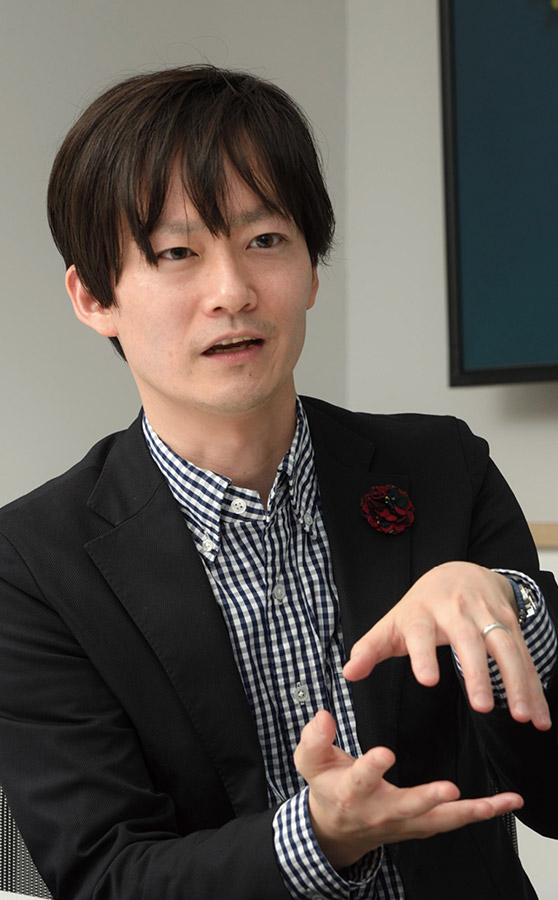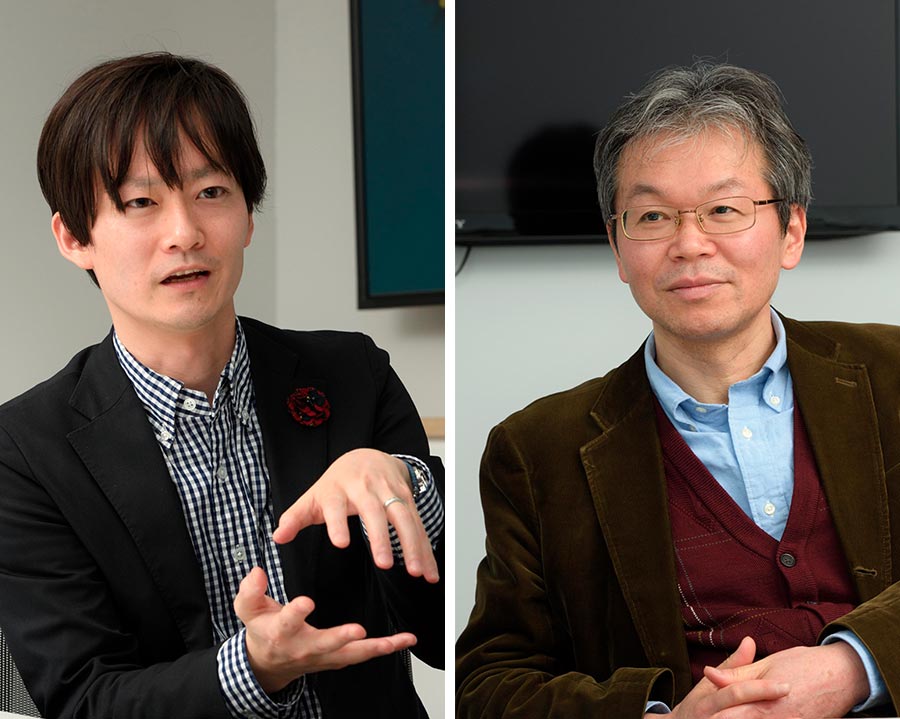Toward a Future where QoL is Satisfied by Solving Social Problems

Masanori Satoh
Manager, Customer Engineering, Google Cloud Japan G.K.
Iwasaki:Today, Google*1 is a company that many children around the world are familiar with. I use its search engine every day to search for technical papers as a researcher. And I enjoy YouTube videos as a personal user. In addition, Google Maps is essential for going anywhere in Japan or overseas. We believe that the Google services that have long been essential to our lives are now part of the social infrastructure.
Satoh:Thank you. Google's mission is “to organize the world's information and make it universally accessible and useful.” Through our products, we provide access to information and useful functions to people everywhere. My team is responsible for Google Cloud, which makes the technologies that underpin all of these Google products available to customers for use in their businesses. For example, Google offers free access for ordinary users to apps such as Gmail, Google Calendar, chat, and video-conferencing. On Google Cloud, these are optimized for business use and provided through G Suite, while Google Cloud Platform provides computing resources, data analytics, and artificial intelligence (AI) services on a pay-as-you-go basis. Corporate and other customers can be confident of access to these services, and we make ongoing enhancements and performance improvements to ensure the timely delivery of a high-value user experience.
Iwasaki:On the other hand, Hitachi has supported the construction and operation of various social infrastructures, such as sophisticated equipment and control systems for power plants, railways, transportation, buildings, and water supplies, and IT systems for financial institutions and public institutions. Recently, people in the world are expecting a sustainable society, for example, the Society 5.0 concept advocated by the Japanese government. This is a vision aimed at achieving better quality of life (QoL) by solving various problems of modern society using cyber-physical systems (CPSs), which combine the cyberspace created by IT technology and the physical technology of the real world. In seeking to bring this about, and although our expertise lies in different fields, I believe that Google and Hitachi have much in common as companies that deal with new social infrastructure.
Satoh:Although Google has mainly operated in the realm of the Internet during the 20 or so years since the company was established, we have recently become more seriously involved in providing products associated with the Internet of Things (IoT). As we do not supply products designed for specific industries, such as railways, transportation, or property, we hope to contribute to bringing about a better society in the future in collaboration with partners such as Hitachi.
- *1
- Google and the Google service and product names that appear in this article are trademarks or registered trademarks of Google LLC.
New Value Arising from Cyber-Physical Systems
Iwasaki:Although there are various names for it, such as digital transformation, digital twin, CPS, etc., the world of IoT, which has been predicted for many years, is becoming more and more realistic. In particular, the rapid progress of digital technology such as AI is a major factor. Can you tell us about Google's latest efforts as a leader in this field?
Satoh:Along with the trends you have identified, there is rising demand for using cloud computers to link together edge devices located in the real world, meaning control systems and other such equipment, and to make use of the data collected from these devices. The means of doing so is the “Cloud IoT,” the area my team is working on. This takes the form of a solution map incorporating a wide variety of products. It provides the ability to link edge data to the cloud in real time and at high speed, analyze that data efficiently, and extract insights that can underpin rapid decision-making in business. Using the Edge Tensor Processing Unit (Edge TPU), a hardware accelerator chip that is purpose-designed for use with TensorFlow, it is also possible to extend AI functions to the edge and perform detailed and timely data analysis at the local level. The technology has proven itself in a wide range of applications, including anomaly detection and automatic prediction of maintenance intervals for factory equipment, and the management of vehicles, inventory, and freight in logistics systems.
Iwasaki:The application of cloud computing has been considered in the area of control systems that we call operational technology (OT). However, these systems often require extremely strict real-time response, and it has not been easy to satisfy that constraint. Likewise, when dealing with large amounts of video data from surveillance cameras, it is not realistic to transfer huge amounts of high definition video data to the cloud. On the other hand, when processing on the edge side, the lack of computing power could not be resolved. We are interested in the Edge TPU you mentioned as a potential technology for overcoming these problems, and we would like to incorporate it into our Lumada platform and verify its effectiveness.
Satoh:One of our image recognition demos showed that the edge processing of data is close to 100 times faster than the previous cloud-based configuration. We provide an evaluation kit for demonstrating the benefits, and I believe that, in the case of video data, it will enable things like using edge computing to select particular scenes of interest, for example.
Importance of Openness

Masaaki Iwasaki
Corporate Chief Scientist
Research & Development Group, Hitachi, Ltd.
Iwasaki:In order to connect various systems involved in people's lives and social activities, it is essential that the interfaces connecting them be standardized. To achieve this, many companies, including us, are currently using open source software (OSS) or open sourcing their software. Google, in particular, has made the container technology used in its cloud services open source and is making a major contribution to establishing de facto industry standards.
Satoh:Openness is part of Google's corporate culture, with much of the technology used within the company being published in technical papers or made open source. The reason we do this is out of a belief that making technology open can rapidly provide customers and other users with a trouble-free experience.
Google has been using the Borg container technology in its own products for more than 15 years, with Kubernetes*2 being an OSS platform that was designed on the basis of Borg. While we can obviously obtain many benefits from running this on the Google Cloud, making it available as OSS means it can also be used in other on-premises or cloud-based systems. In other words, being open source means that systems can operate anywhere in the world, regardless of location. The development of Kubernetes is currently handled not by Google on its own, but in collaboration with many other companies and developers through an organization called the Cloud Native Computing Foundation (CNCF). For Google's part, we continue to provide feedback on actual performance and seek to expand the ecosystem around this base.
Iwasaki:Container technology plays an important role in speeding up software development and it certainly increases the pace at which new ideas can be implemented as software and tried in practice.
Typical manufacturing companies such as Hitachi have long adopted an approach based on self-sufficiency whereby we supplied reliable products to customers made using technologies with which we ourselves had become thoroughly familiar. Nowadays, however, it is all but impossible for a single company to deliver all the systems used in modern society because they are large in size and complex in scope. As the focus of business shifts away from standalone systems toward the value derived from connections to other systems, the requirement is shifting toward integrating with the systems and technologies of partners and other companies on the basis of de facto standards, while also drawing on one's own areas of expertise, thereby supplying customers with optimal solutions in the form of all-encompassing systems.
Hitachi already uses Kubernetes container technology as a de facto standard OSS in Lumada and elsewhere, and our intention for the future is to deploy solutions that are a precise fit with the needs of a wide range of individual customers.
- *2
- Kubernetes is a trademark of The Linux Foundation.
Achieving Safety and Reliability in the IoT Era
Iwasaki:The systems that support social infrastructure, a field in which Hitachi has worked for many years, require absolute stability and long-term sustainability. The idea of putting safety and reliability first has been our corporate culture since its inception. However, as a result of giving priority to stable operation, it is often not easy to make changes such as function extensions and version upgrades to a system that is in operation after completing development and delivering it to a customer. On the other hand, with software becoming open and using various external resources, version upgrades are indispensable. As services provided by other companies around the world continue to change, our systems connected with them will have to rethink how to achieve safety and reliability with fundamentally different ideas.
Satoh:Unless systems are continually modified, there is no scope for introducing innovations. I believe that software upgrades are essential for delivering new value to customers.
How can systems be modified without compromising safety and reliability? The Kubernetes technology we talked about earlier is packed with features for just this purpose. Examples include those features that relate to rollback procedures, which determine how quickly and how reliably a system can be restored to its previous state should a problem arise after a change is implemented, and the development of “data center as a computer” methods that use distributed processing to operate a number of data centers as if they were a single computer in order to provide absolute stability so that systems will continue to operate no matter what happens, examples of which have been made public in the form of articles and OSS.
Another factor is that of human resources. Google has staff called site reliability engineers. Their role is to improve reliability, treating site operation as a software problem, and they are continually working on the problem of how to achieve high-level resolutions of conflicting objectives, including reliability versus speed, operations versus software engineering work, and being proactive versus being reactive.
Finally, there is the organization and corporate culture. While this is not something that can be built in a day, Google is conducting research into organization-wide productivity and the attitudes of individuals. Study of high-performing teams, for example, has found that the psychological safety of people in the team is important. That is, it is important that the environment and the relationships between people be such that everyone feels comfortable about expressing ideas, however outlandish they may be. We also actively engage in change management practices that explain the reasons behind changes so as to overcome the psychological resistance that everyone feels toward change.
Iwasaki:Organization and corporate culture are certainly very important. For many decades, triple redundant logic or rolling updates have been used when examining systems developed by Hitachi, such as railway and financial systems, which require particularly high levels of safety and reliability. I respect the efforts of the people who worked on these systems. However, in the IoT era where software is rapidly evolving, the conventional approach of precisely developing a single system will not meet the required levels of safety and reliability.
From now on, I would like to evolve Hitachi into a company that can achieve high levels of safety and reliability with innovative new technologies while keeping the concepts of safety and reliability first. To achieve this, I believe it will be important to work with young and energetic partners like Google and to learn not only new technologies and methods, but also to have a sense of speed and an open approach. I look forward to deepening the open exchange of technologies and cultures. Thank you for your time today.

